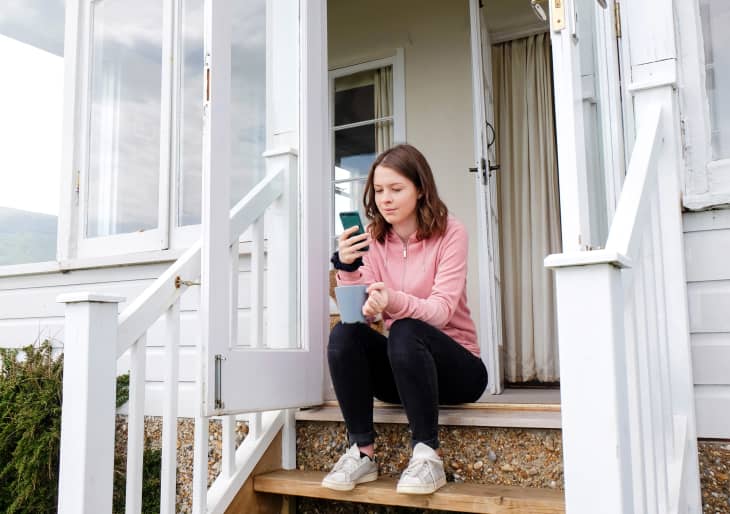I’m 25 and I Can Afford to Live in the City—But Here’s Why I’m Sticking to the Suburbs

Like millions of Americans who graduated with more than $50,000 in student loan debt, I knew it’d be a serious challenge to start my career living in pricey Washington D.C. and pay off my loans. Recent stats show the District’s median rental cost for a one-bedroom apartment is an eye-popping $2,121. At the time, I was only earning $12/hour as a radio station assistant and an unreliable-but-similar rate nannying in the afternoon.
I’d peruse apartment rental websites for hours, frantically trying to make the math work so I could live in a posh downtown neighborhood. It wasn’t happening. Sure, I could have piled into a house with 10 or so roommates, but having recently lived in a boarding house with a few dozen women, I couldn’t emotionally stomach doing that again.
So I picked a roommate and decided to settle into a cozy two-bedroom apartment I discovered on Craigslist for $760/month. The twist? It was in Arlington, Virginia—a sleepy commuter suburb home to a handful of corporate and government headquarters (some of my friends worked in the area and actually commuted all the way from the city). Instead of up-and-coming restaurants, hip shops, and Instagrammable summer festivals, my neighborhood served up chain lunch restaurants and sports bros bars. Not exactly my scene, but it made my wallet happy.
In a city where connections are purportedly everything, making the choice to move outside of the main urban center was daunting. In the immortal words of Ariel from “The Little Mermaid,” “I want[ed] to be where the people are.” Well, maybe not want. I felt I needed to there. How was I supposed to make friends or meet people in my industry if I didn’t live anywhere near them?
Turns out, it ended up being fine.
At first it was tough. My $760 rent was still a chunk of my hourly wage, so I had to rely on an unlimited bus pass to get to work. (The Metro is super expensive!) But I learned to actually like my 45 minutes to one hour commute. I’d listen to podcasts, read bookmarked articles, and answer messages. I came to think of it as a crowded, mobile office—and found that time flies when you’re being productive.
Many of my friends also lived closer to the Washington-Maryland border, so I would have to make plans to see them rather than rely on impromptu neighborhood hangouts. (It’s quite difficult to make plans with someone living an hour away—especially as they’re rarely enthusiastic about meeting in Virginia.) But when people have to put in effort to see you, real friends show themselves quickly—I inadvertently Marie Kondo’d my friend circle to those who wanted to see me enough to meet me near my far-flung apartment for a cheap and easy home-cooked meal.
Flash forward three years later: I’m still living in that apartment in Arlington. Even though I’m making about $2,900 per month after taxes—enough to move downtown and live in an apartment that costs thrice what I currently pay—I’m still sticking to the suburbs. (I will say, it does help that my job pays for my public transportation so I can finally take the train.)
Primarily it’s because I’ve realized how much money I can sock away. Living in a bougie downtown apartment sounds like an avocado-drenched dream, but my millennial plan is admittedly less-sexy: Living debt-free. Though I may be spending 30 more minutes on the subway than my friends who have studios in the city center, I’m literally saving thousands of dollars each year. It’s allowing me to pay $1,000 on top of my just-south-of-$550 monthly student loan payment. My Google spreadsheet-supported estimates show that by aggressively paying them off, I’m additionally saving thousands of dollars in interest, too.
Currently, I’m on track to pay off my balance in 2020; at that point, I can work toward homeownership. This knowledge pays dividends in terms of my mental health. I feel at ease knowing I can always lower my monthly loan payment in case of an emergency.
I’m also finding that when I’m not surrounded by trendy shops and restaurants, I spend less on what I don’t need and more on experiences to share with my loved ones. It’s easier to stay on budget and avoid fast fashion impulse buys when you have to travel to stores. And though it started by necessity, I’ve found I’m committed to living an overall more eco-friendly lifestyle. I’ve hung onto my older-model iPhone, laptop, and television for carbon-emissions reduction reasons, too.
And though I can afford to eat out several nights a week—especially since rent isn’t gobbling up most of my paycheck—I still prefer to hit up one of the area’s happy hours for cheap, but satisfying beer and a bite.
But it’s not all about the money: I’ve come to appreciate having the best of both worlds. I can spend the morning at a quiet brunch spot but get halfway across the city to the heart of the action within an hour. Is an hour long? Absolutely, but I’ve found it’s an easy hour to fill.
This isn’t to say I wouldn’t have loved to spend my 20s living in the center of it all. Of course I would. This isn’t supposed to be a sanctimonious account of how life is better when you scorn what’s in fashion. Trendy neighborhoods are popular for a reason, and part of that reason is that people enjoy living and working there.
But I’ve learned that all neighborhoods have pros and cons—and, for me, there’s a definite pro to trading in that longer commute for a more obstacle-free future. If anything, it’s been great practice for the lifestyle I’ll have once I (hopefully) buy my first home in a couple of years—a decade or so ahead of my city-living peers.